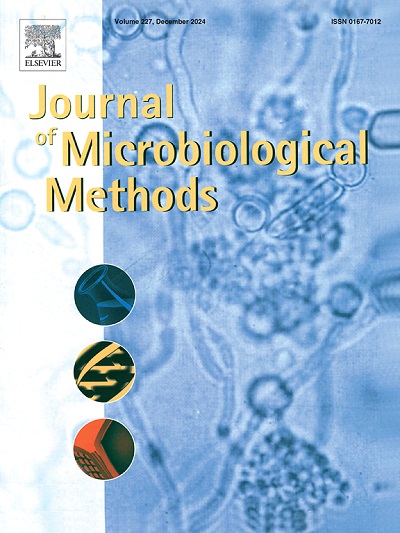Targeting SufC ATPase in Staphylococcus aureus AR465: Insights from an in silico and molecular docking approach
IF 1.7
4区 生物学
Q4 BIOCHEMICAL RESEARCH METHODS
引用次数: 0
Abstract
Staphylococcus aureus AR465 (S. aureus AR465) is a deadly pathogen that often inherits multidrug resistance, where the antibiotics become ineffective against it. The iron‑sulfur (Fe![]() S) cluster assembly pathway has the potential to serve as a new drug target, allowing for the modification of these molecules to be susceptible to oxidative conditions. Our study focuses on the preliminary stage of the Fe
S) cluster assembly pathway has the potential to serve as a new drug target, allowing for the modification of these molecules to be susceptible to oxidative conditions. Our study focuses on the preliminary stage of the Fe![]() S pathway inhibition by inhibiting the SufC protein, unlike previous studies that targeted the final stage. SufC has an Adenosine triphosphate (ATP) binding site. The main goal of this study is to inhibit the SufBCD complex of S. aureus AR465 to bind with other subunits to form an Fe
S pathway inhibition by inhibiting the SufC protein, unlike previous studies that targeted the final stage. SufC has an Adenosine triphosphate (ATP) binding site. The main goal of this study is to inhibit the SufBCD complex of S. aureus AR465 to bind with other subunits to form an Fe![]() S cluster. The Sulfur Utilization Factor (SUF) system plays a massive role in the survival of this pathogen by producing electron carrier proteins which possess Fe
S cluster. The Sulfur Utilization Factor (SUF) system plays a massive role in the survival of this pathogen by producing electron carrier proteins which possess Fe![]() S cofactors. The SufC protein from the SufBCD system was chosen as the main target for the potential inhibitor molecules. SufC is an ATP-binding cassette (ABC) that transfers an Fe
S cofactors. The SufC protein from the SufBCD system was chosen as the main target for the potential inhibitor molecules. SufC is an ATP-binding cassette (ABC) that transfers an Fe![]() S cluster to SufA, which then transports it to an apoprotein involved in electron transport processes. In this research, several drugs were selected which can block this particular stage of the Fe
S cluster to SufA, which then transports it to an apoprotein involved in electron transport processes. In this research, several drugs were selected which can block this particular stage of the Fe![]() S cluster formation pathway. The idea was to competitively inhibit the binding of ATP with the help of inhibitors so that it cannot bind to the desired site of SufC. Eventually, the inhibitor molecule blocks the transfer of the Fe
S cluster formation pathway. The idea was to competitively inhibit the binding of ATP with the help of inhibitors so that it cannot bind to the desired site of SufC. Eventually, the inhibitor molecule blocks the transfer of the Fe![]() S cluster to a newly synthesized apo-protein and kills the pathogen.
S cluster to a newly synthesized apo-protein and kills the pathogen.

在金黄色葡萄球菌AR465中靶向SufC atp酶:来自硅和分子对接方法的见解
金黄色葡萄球菌AR465(金黄色葡萄球菌AR465)是一种致命的病原体,通常遗传多药耐药性,抗生素对其无效。铁-硫(FeS)簇组装途径有潜力作为新的药物靶点,允许对这些分子进行修饰,使其易于氧化条件。我们的研究侧重于通过抑制SufC蛋白抑制FeS通路的初步阶段,而不像以往的研究针对最后阶段。SufC具有三磷酸腺苷(ATP)结合位点。本研究的主要目的是抑制金黄色葡萄球菌AR465的SufBCD复合体与其他亚基结合形成FeS簇。硫利用因子(SUF)系统通过产生具有硫利用因子辅助因子的电子载体蛋白在病原菌的存活中起着重要作用。从SufBCD系统中选择SufC蛋白作为潜在抑制剂分子的主要靶点。SufC是一种atp结合盒(ABC),它将FeS簇转移到SufA,然后SufA将其转运到参与电子传递过程的载脂蛋白。在本研究中,选择了几种可以阻断FeS簇形成途径这一特定阶段的药物。这个想法是在抑制剂的帮助下竞争性地抑制ATP的结合,使其不能结合到所需的SufC位点。最终,抑制剂分子阻止FeS簇向新合成的载脂蛋白转移并杀死病原体。
本文章由计算机程序翻译,如有差异,请以英文原文为准。
求助全文
约1分钟内获得全文
求助全文
来源期刊

Journal of microbiological methods
生物-生化研究方法
CiteScore
4.30
自引率
4.50%
发文量
151
审稿时长
29 days
期刊介绍:
The Journal of Microbiological Methods publishes scholarly and original articles, notes and review articles. These articles must include novel and/or state-of-the-art methods, or significant improvements to existing methods. Novel and innovative applications of current methods that are validated and useful will also be published. JMM strives for scholarship, innovation and excellence. This demands scientific rigour, the best available methods and technologies, correctly replicated experiments/tests, the inclusion of proper controls, calibrations, and the correct statistical analysis. The presentation of the data must support the interpretation of the method/approach.
All aspects of microbiology are covered, except virology. These include agricultural microbiology, applied and environmental microbiology, bioassays, bioinformatics, biotechnology, biochemical microbiology, clinical microbiology, diagnostics, food monitoring and quality control microbiology, microbial genetics and genomics, geomicrobiology, microbiome methods regardless of habitat, high through-put sequencing methods and analysis, microbial pathogenesis and host responses, metabolomics, metagenomics, metaproteomics, microbial ecology and diversity, microbial physiology, microbial ultra-structure, microscopic and imaging methods, molecular microbiology, mycology, novel mathematical microbiology and modelling, parasitology, plant-microbe interactions, protein markers/profiles, proteomics, pyrosequencing, public health microbiology, radioisotopes applied to microbiology, robotics applied to microbiological methods,rumen microbiology, microbiological methods for space missions and extreme environments, sampling methods and samplers, soil and sediment microbiology, transcriptomics, veterinary microbiology, sero-diagnostics and typing/identification.
 求助内容:
求助内容: 应助结果提醒方式:
应助结果提醒方式:


